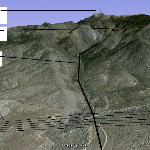 Jeff Harti Apr 6, 2015 11:44 |
Hi Paul,
Thank you for submitting your proposal. Myself and the other fellows look forward to reading it in detail.
Regards,
Jeff Harti
|
 Manohar Lal Baharani Apr 10, 2015 11:33 |
Quite environmental friendly move. How about the intermittency and variability aspect of solar energy drawl?. I look forward to learning more on this proposal. Thanks. Manohar
|
 Paul Klinkman Apr 15, 2015 09:18 | Proposal contributor
If I have a 1 acre or a 10 acre solar heat collecting field, solar heat generally comes down and gets trapped. I happen to use glass objects from the waste recycling stream as a top layer.
The sun generally shines through the glass objects or possibly through slightly smoothed glass shards between these glass objects. The sun hits solar paint on 2" rocks and most of the heat goes into the rocks. Any radiating heat emitted by the solar paint surface will be a certain wavelength of infrared specifically picked to bounce back off of the glass and back down. Any convective heat coming off of the rock will be pulled downward by the laminar flow of air.
If a cloud goes over the sun for ten minutes, the rocks won't get that much colder in ten minutes.
The entire length of my diagonal solar chimney has either a rock or an earth bottom. It absorbs heat during the heat-producing part of the day and releases heat during the evening and night.
The bottoms of air trenches are enhanced with a rock layer under a loose fairing. Some moving air within each trench still mixes with the rocks and with the underlying ground. An example of large areas of earth absorbing and releasing heat over a period of days can be seen in roaldgundersen.com triangular greenhouses. The massive amount of heat stored in the greenhouse's soil is quite a bit more in scale than lateral heat losses through the soil to the outside winter, so the greenhouse never freezes.
The net effect of all of this natural thermal buffering is to even out the airflow up the chimney from minute to minute, from day to night and even a bit from season to season. The question is reduced to, how much will the intermittency drop, and how much extra per kilowatt-hour would the electric utility pay to drop intermittency a bit farther? All that we need for less thermal intermittency is more gravel or stones in the recipe.
One big concern is precipitation swamping any pipe system in the solar field and carrying away valuable heat. The monster storm is going to happen, but not that often. We have to design a flood system that carries away light precipitation without carrying away too much heat, and that at least survives a monstrous thunderstorm and dries out in about one day of sunshine or less. Again, the system needs to be balanced between its remaining intermittency issues and low cost.
I've seen nuclear power plants trip off early when an entire electric grid is collapsing. Does anyone hold the de facto intermittency of nuclear power plants against them? Should we?
|
 Keating Willcox Apr 26, 2015 07:21 |
excellent. Consider a community of 50 homes each on an acre site, and most of each site turned into a solar collector, using your design. The air from each source is shared by a mountainside 300 meter chimney. What is the cost for each house's collector, and what is the income stream?
|
 Keating Willcox Apr 26, 2015 07:24 |
possible solar collectors, black plastic boxes, connected, self supporting, or perhaps some form of fresnel lens setup.
http://morgansolar.com/ aimed at a steel air duct
http://www.yeloha.com/sunpartner to share power
|
 Paul Klinkman May 8, 2015 07:42 | Proposal contributor
"excellent. Consider a community of 50 homes each on an acre site, and most of each site turned into a solar collector, using your design. The air from each source is shared by a mountainside 300 meter chimney. What is the cost for each house's collector, and what is the income stream? "
I hadn't thought of putting any home right near the collector field. The field will be at least as shiny as a used car lot, and so a privacy fence is recommended. Also, trees and people go together, but trees will shade the collector field. I've experimented with solar heat collecting walkways and driveways, but such collectors are kind of expensive to build. The driveway collector has to support a truck.
The higher the chimney rise, the more electric power is produced per acre of collector. The Manzanares chimney was only 0.5% energy efficient. I believe that an order of magnitude improvement is possible.
The Manzanares chimney produced 50 kilowatts from 11 acres of collector and a 200 meter chimney. I'm going to assume for now that power output is linearly connected to chimney height. I don't exactly like building a mere 300 meter chimneey, but you asked.
25 acres (half of the land) and a 300 meter chimney would produce about 375 kilowatts on a sunny day. Storing the latent heat in the soil would lead to perhaps 200 kilowatts with (given a bargain system) 80% fuel displacement.
I pencil in a cost of about $2,000,000 for the collector field, $500,000 for the tunnel and $400,000 for the generating equipment. Amortized over 20 years, the generator produces electricity at $.127 cents per kilowatt-hour, minus two cents per kwh = $.107 /kwh if the renewable energy credit is sold off. Everything but the generator is likely to last 50 years. If you can get a 5% loan, you're getting moderately dependable power for 11 cents per kwh.
To decrease the cost per kwh, use a taller chimney. Building 100m onto the top of the chimney at the mountain's top is a possibility. Creating a vortex effect at the chimney's top is another possibility.
|
 Paul Klinkman May 8, 2015 08:54 | Proposal contributor
"possible solar collectors, black plastic boxes, connected, self supporting, or perhaps some form of fresnel lens setup. "
Plastic boxes are closed systems. My absorbers pull air in slowly, in a laminar flow, recapturing heat that normally would convect away in a closed air loop.
The beauty of a hole-filled air absorbing system is that we're building a gutless wonder of a solar heat absorber surface. There's remarkably little to the whole thing. Land purchase costs and unimproved real estate taxes almost become a limiting cost of energy production, that's how cheap it gets.
|
 Dustin Carey Jun 4, 2015 09:37 |
Hi Paul,
Thanks for the very interesting proposal. I seem to recall a project not unlike this one (but freestanding) being launched in Mongolia a few years ago. Have you come across any information from existing structures on the cost per kWh from alternative designs to corroborate your financial estimates?
I apologize if I missed the explanation within the proposal, but what purpose does building it on a mountain perform opposed to a freestanding structure? If it's the thermal gradient between the collected solar heat at ground level and the cooler atmospheric temperatures which drives the airflow which generates electricity, would the sun heating the mountain below the chimney not reduce the gradient over the span of the chimney, or is that part of the plan?
Best regards,
Dustin Carey
|
 Paul Klinkman Jun 6, 2015 04:51 | Proposal contributor
I either read or heard an ugly rumor that the Chinese effort had a financial disaster. They used ordinary window glass instead of tempered glass, which would have worked. At some point either cold drops of rain or hail came down on the glass panes and they reportedly had massive breakage.
I have three intuitive reasons to expect that recycled glass objects won't have the same issue: First, recycled glass objects often have to deal with thermal issues. Jars typically have to deal with sterile canning temperatures. Second, jars and bottles are built not to break that easily. They're thicker than glass panes, with a far shorter span from end to end, and they have built-in 3-D support because they aren't flat panes. Third, at least for the initial air intake, given a downward laminar flow, The glass objects aren't operating at extremely high temperatures. Downward convection carries their heat away.
My only cost comparison information is a probably optimistic projection from the Manzanares prototype. They expected a cost of $.25/kwh. Going by their numbers, I'd have to lower the chimney cost and the collecting field cost by a factor of 5 to hit $.05/kwh, or I'd have to raise the chimney effectiveness by a factor of 5 without raising its cost. I believe that by simply going up a 1,000 meter mountain versus the Manzanares prototype 200 meter tower, I can get five times the power but at the same construction price, with far less chance of a catastrophic tower collapse and easier ground-based long-term maintenance.
In addition, a layer of recycled glass objects on the ground is available for the cost of trucking the objects plus the cost of manually positioning the objects on the rocks below. we'll also need some solar black paint, and the air channel system will take some of our dollars. I compare my collector to the Manzanares system, heavy plastic rigged on tent poles with many guy wires. My collector field is far beyond a factor of ten cheaper than theirs. The cost of the collection field is the critical factor with updraft chimneys. Get the cost of solar warm air collection down to perhaps 1% of the total (environmental, health)cost of heating air with natural gas and the game is over.
At the end, I added a considerable fudge factor to get my cost number up to $.03/kwh. Things go wrong. If nothing goes wrong then I'll have a bit of egg on my face but nobody will care.
Also, my on-ground system handles snow, hail and wind because it's so close to the ground. If for some reason a jar ever breaks, the system's output doesn't drop more than 0.0001%. For aesthetics we might want to eventually clean up the glass shards and put in a new jar.
Part of my heat storage, which lowers intermittency during electric generation, is literally dirt-cheap because it's the in-situ dirt.
|
 Paul Klinkman Jun 6, 2015 04:05 | Proposal contributor
There should be no energy production difference between building a freestanding structure and building up the side of a mountain. However, building anything 1000 meters high takes money. Building a chimney up the side of a 1000 meter mountain is relatively affordable. Also, a 1000 meter vertical chimney is an aviation hazard.
If there's any difference in energy production between a vertical and a diagonal tube, it shall be related to the extra air friction that a longer tube creates. However, wider tubes allow for slower air flow and that minimizes the air friction issues, at a relatively affordable cost.
|
 Paul Klinkman Jun 6, 2015 04:13 | Proposal contributor
What drives the chimney is the mass of the column of air inside the chimney, versus the mass of an equivalent vertical column of air directly over the entry point of the air. Hotter air has less mass per cubic meter (hot air balloons rise). The temperature near the mountain's surface should be irrelevant.
|
 Paul Wolfram Jun 13, 2015 09:46 |
Thank you for your proposal submission. Until now, I have been unaware of this kind of technology. Sounds like it could be a promising solar design option.
I think it would be very useful for better understanding if you could provide a sketch how the facility would look like?
As far as I understand, the current system can only produce small-scale electricity. So my question is: Even if the system will be enhanced, what are the advantages of this system compared to concentrated solar power systems that are already able to produce electricity in the Giga Watt scale?
|
 Paul Klinkman Jun 17, 2015 08:21 | Proposal contributor
I could provide a sketch, except I didn't see any facility on this web site for uploading a sketch or image.
The current system can only provide small-scale electricity, specifically because nobody wants to sink money into a large scale system. However, if a ten meter diameter archway can be built up the side of a mountain, there isn't any good reason not to build a 100 meter diameter archway up that same mountain. For ten times the archway height, we would get at least 100 times the airflow up the mountain. Also, with wider tunnels, people would start thinking of building slightly taller towers off the top of a mountain for a bit of extra power conversion. We'd have to build more air collecting tunnels down at the bottom for gathering the air, so at some place economy of scale fails, but I could see a one gigawatt plant.
The prime advantages of this system over concentrated solar power are rock-solid reliability due to its having almost no moving parts except for the turbine, zero bird or bat kill issues (the downfall of current concentrated power systems), extreme environmental friendliness so that rock climbers could climb it while in use, a good degree of robustness -- even in a war zone the system could probably be patched after a handful of RPGs hit it, appropriate technology materials construction is possible, remarkably low engineering requirements leading to truly sustainable lifetime costs, and it sucks the smog and heat out of a valley, lowering asthma deaths. The Manzanares prototype was dependable, so we would expect no less of the next installation except one or more of the improvements might not work.
|
